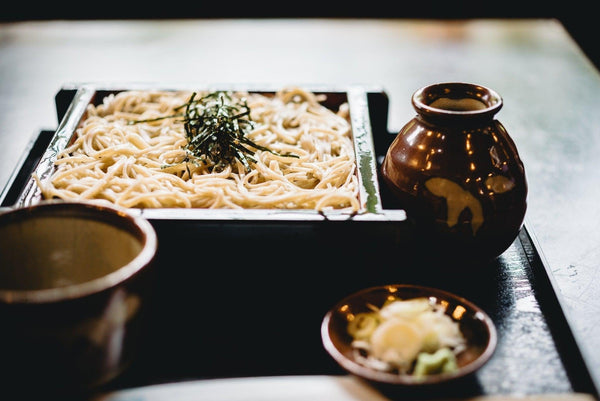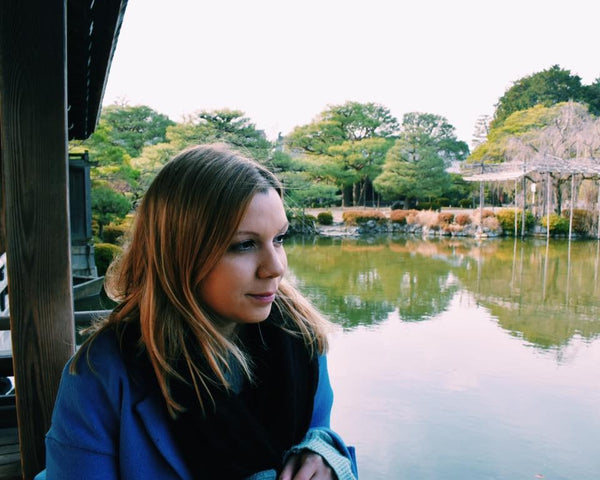The Ultimate Guide to Soba Noodles

Jump to:
What are soba noodles and where do they come from? A brief history.
Soba noodles are a type of Japanese noodle made from buckwheat flour. They were first introduced to Japan by Zen Buddhist monks from China in the 13th century. The monks would prepare soba noodles by mixing wheat flour with water and then adding it to boiling water. It was not until the 16th century that soba became well-known in Japan, when they became popular at tea ceremonies.
Soba noodles became even more well-known during Japan’s Edo period (1603-1867) when traveling soba vendors began to sell their noodle soup in portable stalls during the evenings after restaurants closed, satisfying the late-night hunger cravings of Tokyoites. Soba noodles quickly became a fast food of the Edo era, as they were convenient, cheap, healthy, and filling without being heavy on the stomach.
There are thousands of soba restaurants in Japan today. Some soba restaurants in Tokyo date back more than 300 years and have been run by the same families for generations. You can easily recognize a soba restaurant by its short curtain hung at the entrance with the word soba (そば or 蕎麦) written in Japanese.
Soba noodles are also traditionally eaten in Japan on New Year’s Eve in a dish called Toshikoshi Soba which consists of soba noodles served in a hot dashi soup with finely chopped spring onions.

What do soba noodles taste like?
Soba noodles are around the same consistency as spaghetti and have a firm texture. They can be eaten hot or cold and are usually served with a dipping sauce or soup known as tsuyu in Japanese, which is made from soy sauce, dried bonito broth, sugar, and mirin.
Are soba noodles the healthiest type of noodle? Soba nutrition facts.
Soba noodles are made mainly from buckwheat, unlike other types of noodles which are made 100% from wheat flour. Buckwheat itself is a gluten free ingredient however when making soba noodles it is common to add a certain amount of wheat flour (usually 20 or 40%). For 100% buckwheat flour noodles, always look for ju-wari soba (十割そば).
Buckwheat is rich in protein and has eight kinds of indispensable amino acids. In contrast, rice and other types of flour are limited in amino acids.
Soba is also a rich source of vitamins. For instance, it has 5 or 6 times more mineral iron rate than rice or wheat flour. The levels of potassium (cilium) and Vitamin B are much higher in comparison. Finally, it is also a rich source of fiber, almost like spinach or burdock. Eating soba noodles is filling but light on the stomach, and its nutritional values make it a well-rounded meal.
What is the difference between soba, ramen, and udon noodles?
The difference between soba and other types of Japanese noodles is that soba contains buckwheat flour while others contain wheat flour or rice flour. Buckwheat has a strong flavor which is why it is mixed with other flours, but it also makes them more nutritious.
Ramen noodles are made from wheat flour, water, salt, and a type of alkaline water called kansui, which is what gives the noodles their springy texture and yellow tint. Although ramen noodles can vary in size and shape, ramen dishes are often categorized according to their broth base: soy sauce, miso, or salt.
Udon noodles are thicker than other types of Japanese noodles such as soba or ramen and have a slightly chewy and salty texture. The noodles are made from wheat flour dough which is then cut into strands or rolled into small squares and either boiled or deep fried before being added to the soup or stir fried with other ingredients.

What makes a good soba noodle?
According to soba experts, there are a few points to keep in mind to determine how good a soba noodle dish is. Firstly, the freshness of the noodle is very important – the noodles should be as freshly made and freshly cooked as possible.
If you are not able to use freshly made soba and are cooking with dried soba, then look for a noodle that has a higher percentage of buckwheat – at least 50% is good. The best flour comes from Hokkaido so any soba noodles containing this are more likely to be good quality.
The tsuyu dipping soup is also a crucial element when it comes to making good soba noodles as this is where much of the taste comes from. The main ingredients are soy sauce, katsuobushi broth, sugar, and mirin. Getting the right balance of ingredients will have a huge impact on the soup’s taste.
8 popular soba noodle dishes to try at home
In Japan you can find many variations of soba dishes, depending on the season and region. For example, many soba restaurants create dishes that use seasonal ingredients to reflect Japan’s four seasons: shiitake and enoki mushrooms in autumn, oysters in winter, and clams in springtime.
You can also find local specialities that vary from region to region. In the Kanto region, soba noodle soup has a strong flavor and is dark in color but in Kansai a light-colored soy sauce is used instead. In Kyoto you can try eating green tea soba made with matcha powder from nearby Uji, whilst in Yamagata Prefecture their speciality is Ita Soba – larger than average soba noodles served on big boards.
If you need some inspiration of what to do with your soba noodles, check out these 8 popular soba dishes you can try making:
- Kake soba – a simple dish of soba noodles served in a hot broth made from soy sauce, mirin, and dashi. Use spring onions and shichimi seasoning to add flavor or add an optional slice of kamaboko fish cake.
- Kitsune soba – hot or cold soba noodles topped with fried tofu. Known as “tanuki soba” in Osaka area.
- Tanuki soba – outside of Osaka, tanuki soba are soba noodles (hot or cold) topped with crunchy pieces of tempura batter called tenkasu.
- Oroshi soba – this cold noodle dish is made up of chilled soba noodles topped with grated daikon, spring onion, and served with a cold noodle sauce.
- Tensoba – soba noodles served with tempura such as shrimp or squid, or vegetables.
- Tororo soba – soba noodles served with grated yamaimo (Japanese mountain yam).
- Hiyashi-tsukimi soba – soba noodles topped with a soft-boiled egg.
- Sansai soba – soba served with wild vegetables on top of the noodles in hot broth.
How to cook soba noodles
Cooking soba noodles is quick and simple, just boil them in water for around two and a half minutes, making sure the water doesn’t overflow from the pan. Once cooked, you can add your soup which is usually made from soba dashi (a Japanese soup stock) and soy sauce or dipping sauce. There are also other ingredients which can be added to the soba noodle dish such as sesame seeds, green onions, and mustard greens. One thing that sets this dish apart from others is that it does not use any oil in its preparation process – just water.

How to eat soba noodles
For hot soba dishes, use chopsticks to eat the noodles, slurping as you put the noodles into your mouth to enhance the flavor and cool the noodles down. You can drink soba broth directly from the bowl, no spoon required.
For cold soba served with dipping sauce, try the sauce and season as you like with condiments such as wasabi or green onions. Dip the noodles into the sauce and eat whilst slurping. If you find yourself in a soba restaurant with a small teapot you can use this water (in which the noodles were cooked) to add to the dipping sauce after you finish eating the noodles to make a soup.

Where can I buy soba noodles online?
You can find authentic Japanese soba noodles and many of the ingredients to make delicious soba dishes on the Japanese Taste website. Try cooking with these premium soba noodles made with 80% buckwheat from Hokkaido, or add some color to your dishes with these soba noodles mixed with high-quality matcha green tea.
You can also find accompaniments, condiments, and sauces to go with your soba dishes like this ready-made soup base that can be used for hot broth or a cold dipping sauce, tenkasu tempura bits to make tanuki soba, or tempura flour to make tensoba.

0 comments